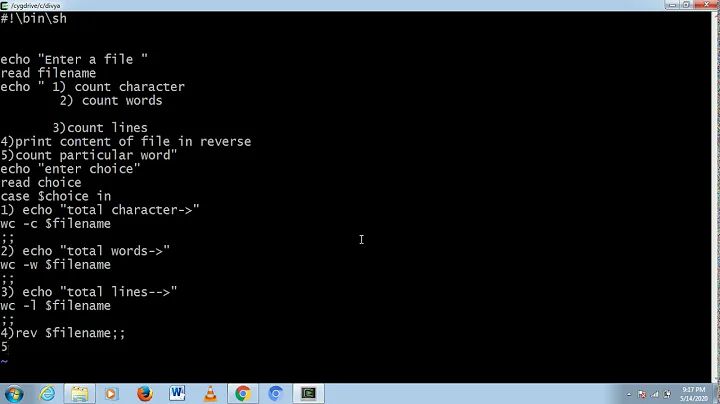How to add line numbers in every line using shell command?
Solution 1
If you want the same format that you have specified
awk '{print NR "> " $s}' inputfile > outputfile
otherwise, though not standard, most implementations of the cat command can print line numbers for you (numbers padded to width 6 and followed by TAB in at least the GNU, busybox, Solaris and FreeBSD implementations).
cat -n inputfile > outputfile
Or you can use grep -n (numbers followed by :) with a regexp like ^ that matches any line:
grep -n '^' inputfile > outputfile
Solution 2
The right tool for this job is nl:
nl -w2 -s'> ' file
You may want to tune width option according to the total number of lines in the file (if you want numbers to be aligned nicely).
Output:
1> PSS-A (Primary A)
2> PSS-B (Primary B)
3> PSS-C (Primary C)
4> PSS-D (Primary D)
5> PSS-E (Primary E)
6> PSS-F (Primary F)
7> PSS-G (Primary G)
8> PSS-H (Primary H)
9> PSS-I (Primary I)
10> SPARE (SPARE)
Solution 3
In Linux/Unix, there are almost always multiple ways to do common tasks. Just for completeness, here are some other ways you can do it besides the obvious:
pr -t -n [file]
From an old command to format text to send to a line printer. The '-t' will omit header and footer information that are not relevant to a terminal.
Here's a cute sed method that prints the line number on every other line. We use 'paste' to fold them into a single line:
sed = /etc/passwd | paste - -
Or, we can use the one true editor, ed:
echo '1,$n' | ed -s [file]
Or, ex, vi's non-cursor-addressing predecessor:
printf 'set number\ng/^/p\n' | ex /etc/passwd
And one final complicated answer, requiring ksh93 or bash (and the seq command. Using the .. range and an eval statement is left as an exercise):
paste <(seq $(wc -l < [file])) [file]
Tested on Debian Linux, FreeBSD, and Solaris 10 (the last fails there because of no 'seq').
Related videos on Youtube
Nainita
Updated on September 18, 2022Comments
-
 Nainita over 1 year
Nainita over 1 yearMy file,
PSS-A (Primary A) PSS-B (Primary B) PSS-C (Primary C) PSS-D (Primary D) PSS-E (Primary E) PSS-F (Primary F) PSS-G (Primary G) PSS-H (Primary H) PSS-I (Primary I) SPARE (SPARE)Output file,
1> PSS-A (Primary A) 2> PSS-B (Primary B) 3> PSS-C (Primary C) 4> PSS-D (Primary D) 5> PSS-E (Primary E) 6> PSS-F (Primary F) 7> PSS-G (Primary G) 8> PSS-H (Primary H) 9> PSS-I (Primary I) 10> SPARE (SPARE) -
 Nainita over 8 yearsYes...both the commands are working.... but in
Nainita over 8 yearsYes...both the commands are working.... but incatcommand its printing the line numbers... but not exactly what I wanted.... butawk '{print NR "> " $s}' inputfile > outputfilegives me the desired output.... :-) @amit kumar -
 vinc17 over 5 years
vinc17 over 5 years -
myrdd over 5 years@StéphaneChazelas indeed, thanks a lot! Note that
$'...'syntax is bash-specific. -
Sridhar Sarnobat over 5 yearsMy heart sank when I saw that
seqdidn't do it. Thank god fornl -
 Stéphane Chazelas about 5 years@myrdd,
Stéphane Chazelas about 5 years@myrdd,$'...'comes from ksh93 and is also supported byzsh,mksh, busybox sh, FreeBSD sh and bash at least. It's not standard yet, but is planned for inclusion in the next major POSIX version. -
myrdd about 5 years@StéphaneChazelas thanks. for reference, there's a question on
$'...'(ANSI-C Quoting) portability: unix.stackexchange.com/questions/371827/… -
Onnonymous almost 5 yearsI like how
nlcan set a starting number with-v. -
xeruf almost 4 yearsplease add an explanation, I'd love to do this with sed, but I don't understand the command :)




